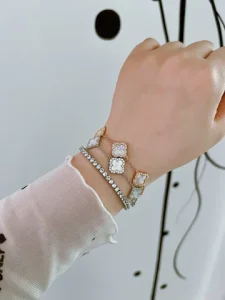There are advantages to both cubic zirconia rings and diamond rings, but the two differ in terms of cost, durability and general charm. Price has the be ever so prominent inconsistencies. Cubic zirconia (CZ) stones that are of good quality can cost around $20 to $50 per carat, and a diamond of the same size will range anywhere from between magin compared with CZ price: so reaching huge differences in prices going up to sometimes over US$2.000-15.000+ for high end easily purchasable diamonds! That makes cubic zirconia a sought after and equally breathtaking solution for those who want inexpensive jewelry that still has stunning visual appeal.
Cubic zirconia stones are nearly identical to diamonds in appearance, designed so that even the amateur observer cannot easily tell them apart. Each stone has sufficient brilliance and fire, with CZ even having more dispersion which means a rainbow effect at times (which some people find appealing). Although this increased brilliance can sometimes create a more unnatural look to CZ as opposed the diamond's more understated, classic sparkle. Further, cubic zirconia comes in at 8 to 8.5 on the Mohs scale of hardness, with diamonds landing a perfect score of…yes you guessed it -10 – meaning that diamond is much more durableanches than cuicbornia and silicone washranges are also withincuishan- cmasticerroorluing into consideration for wearing every day jewellery items such as rings or bangleances. However, this difference also makes CZ rings more susceptible to scratches and wear so they will need replacement in 2–3 years if used daily.
Cubic Zirconia is made in a lab, created from zirconium dioxide which can be more controlled for clarity and cut quality as well as having the same color throughout the product. Diamonds, either natural or lab-grown on the other hand quite often have some inclusions and variations of colour that will affect there price and rarity. Cubic zirconia suits those who need a perfect jewelry item with an excellent quality level but comparatively at lower rate. But as timeless means of connection, diamonds bestow everlasting value and signify opulence and heritage (leading them to remain the most chosen selection when it comes to significant phases in life such as engagements/marriages).

Ethically speaking, cubic zirconia rings cannot be sourced through the horrible channels of conflict diamonds and are a cleaner choice for green-minded jewelry shoppers("${first}"); Although lab-grown diamonds are an ethical alternative, they still cost much more than CZ. Lorraine Schwartz, an aboriginal jewelry designer said, ” It's the sentiment behind the stone that matters most. That insight exemplifies why cubic zirconia rings have become pivotal among inexpensive tokens of commitment.
While cubic zirconia is very affordable and ethical, it has almost no resale value. No guarantees, but top-tier stones (with a heavy emphasis on the 'top') will likely hold value or increase in price as with any commodity like wine and artwork. One of the most important things for those who invest in jewelry is its return on investment. Industry experts say that diamonds can at best garner 50% of the original purchase price through a resale, adjusted with market forces while cubic zirconia has no secondary market to speak of.
If you are trying to find a cheaper but just as stylish diamond alternative, cubic zirconia rings have so many different styles and settings that can be customized. They can make for a perfect keep it simple type ring, right hand fashion rings or even temporary engagement rings (while the real one is in production) – as well as perhaps some travel jewelry (no need to worry if you leave it behind at those prices!).
Overall, cubic zirconia rings offer a good alternative to diamond rings in terms of price and persuasion as well but are not that much worth associated with durability or the amount retained over time. The result is a win for the buyer who values both in their purchase of CZ. That said, many are still relying on diamonds as their symbol of love and investments. The three approaches provide their own unique benefits, with consumers deciding simple based on individual demands or wants together with fiscal goals.